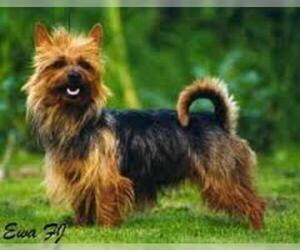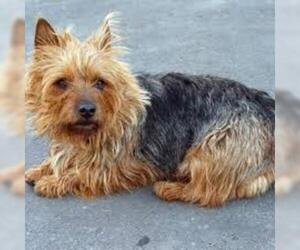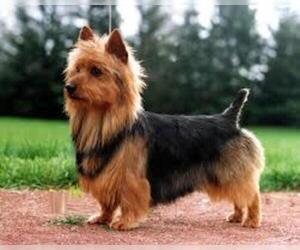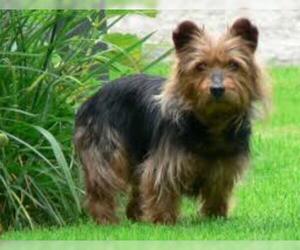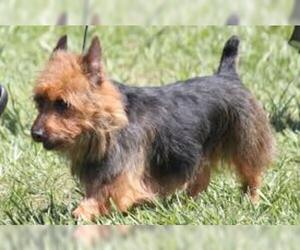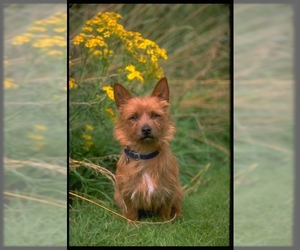
All about Australian Terrier dog breed
A.K.A. :Aussie Terrier, Aussie, Oz Terrier, Australian Rough, Bush Terrier, Aussie Scrapper, AT, Down Under Terrier, Outback Terrier, Aussie Rascal, Little Aussie, Aussie Earthdog
Size
Grooming requirements
Exercise requirements
Good with other dogs
Watchdog ability
Energetic
Training requirements
Playful
Affectionate
Good with other pets
Good with children
Good with strangers
Winter
Summer
Healthiness
Protective
Life Span
| Pure Breeds | Member |
| Breeds A - Z | A |
| Breeds by Group | Terrier |
| Breeds by Trait | Hypoallergenic Low Shedding |
| Overview: | The Australian Terrier is a small, spunky breed originating in Australia in the early 19th century, developed to hunt rats and snakes. Physically, they are sturdy and compact, typically weighing between 12-18 pounds and standing around 10-11 inches tall. Their most striking feature is their rough, wiry coat, which comes in blue and tan, sandy, or red, often accompanied by a soft topknot. Temperamentally, "Aussies" are known for being alert, intelligent, and confident, with a playful and affectionate nature towards their families. They are generally good with children and can adapt well to apartment living if provided with sufficient exercise and mental stimulation, as their terrier instincts give them an active disposition. While generally a healthy breed, they can be prone to certain conditions like patellar luxation, Legg-Calve-Perthes disease, and diabetes, making regular veterinary check-ups important for these charming and adaptable companions. |
F.A.Q.
All You Need to Know About the Australian Terrier Breed
Originating in Australia, the Australian Terrier is a small, sturdy dog known for its big personality. They boast a confident, spirited temperament, making them excellent, playful companions. Physically, expect a compact build with a wiry, weatherproof coat, typically blue and tan or sandy. Their expressive eyes and distinctive topknot add to their charm. While generally good with children and other pets when socialized early, their terrier instincts mean they're always up for an adventure. They adapt well to both apartment living and houses, provided they receive regular mental stimulation and moderate exercise – a daily walk and playtime suffice. Grooming is relatively low-maintenance, requiring weekly brushing to prevent mats and occasional stripping. The Australian Terrier is generally healthy, though some may be prone to patellar luxation or Legg-Calve-Perthes disease. This loyal, intelligent breed makes a fantastic addition to active families seeking an affectionate and robust companion.Australian Terrier Weight: Average Size & Healthy Weight for Australian TerrierThe average weight of an adult Australian Terrier is between 12-14 pounds.Typically, both male and female Australian Terriers fall within this range, with very little noticeable variation in healthy weight for Australian Terrier based on sex. Potential owners can expect an adult Australian Terrier to be a compact, sturdy companion.
What is the average height of an Australian Terrier?Looking for an "Australian Terrier height" to see how they'll fit into your home? Australian Terriers are a small, sturdy breed, and their "average size" is quite consistent.A typical adult Australian Terrier stands between 10 to 11 inches tall at the shoulder. This measurement refers to the height from the ground to the top of their shoulder blades.While there isn't a significant difference in height between males and females, you might find some slight variations due to individual genetics. Some Australian Terriers may be on the lower end of the 10-inch range, while others might reach the top of the 11-inch mark. Rest assured, if you're asking "how tall is an Australian Terrier," this 10-11 inch range is a reliable guide for this wonderful breed!
The Australian Terrier comes in a few distinct colors, with some being AKC recognized Australian Terrier colors and others considered rare coat types or exotic Australian Terrier variations.Officially recognized by the AKC and other major kennel clubs are:* Blue and Tan: This is the most common and classic Australian Terrier color. The body is a dark steel blue, and the legs, muzzle, and chest are a rich tan.* Solid Sand: This color can range from a light cream to a darker sandy red.* Solid Red: A vibrant red, often with some lighter shading.While not recognized by major kennel clubs, potential buyers might encounter discussions or claims of rare Australian Terrier coat types or exotic Australian Terrier variations such as chocolate, brindle, fawn, cream, white, blue, lilac, or merle. It's important to understand that these colors are not accepted standards for the Australian Terrier and may indicate a different breed mix or a non-standard genetic mutation. Reputable breeders focus on the recognized colors and maintain breed integrity according to official standards. For AKC recognized Australian Terrier colors, stick to Blue and Tan, Solid Sand, and Solid Red. Pricing typically reflects health, temperament, and adherence to breed standards rather than the rarity of an unaccepted coat color.
The Australian Terrier personality is renowned for being spirited, intelligent, and affectionate. These charming dogs are loyal companions who form strong bonds with their families. Generally friendly and sociable, they thrive on interaction and are adaptable to various living situations, including apartment living, provided they receive sufficient exercise and mental stimulation. Their temperament of Australian Terrier with children is typically good; they can be playful and patient companions, especially with well-behaved children who understand how to interact with a dog. However, like all breeds, early socialization is key. When it comes to other pets, particularly smaller ones, their terrier instincts for chasing may surface, so careful introductions and supervision are recommended. They can coexist peacefully with other dogs if properly introduced and socialized from a young age. Overall, the Australian Terrier is a lively, loving, and alert breed that makes a wonderful and entertaining family pet for those seeking a devoted companion.
The Australian Terrier temperament is generally described as spirited, alert, and affectionate, making them wonderful companion dogs. They are known for their loyalty and devotion to their families. Australian Terriers are typically friendly with people, though some can be a little reserved with strangers initially, quickly warming up with proper socialization. Their compact size and adaptable nature make them surprisingly well-suited for apartment living, provided they receive adequate daily exercise and mental stimulation.
When it comes to children, they are generally sociable and tolerant, especially if raised with them. However, like all breeds, supervision is always recommended with very young children. Their terrier instincts mean they can be prone to chasing smaller animals, so their behavior with other pets (especially cats or rodents) needs careful introduction and management. They can coexist peacefully with other dogs, particularly if socialized from a young age.Australian Terriers possess a keen intelligence, but this also means they can exhibit a streak of stubbornness. Consistent, positive reinforcement training is key to managing this. While not overly sensitive, they respond best to gentle, firm guidance rather than harsh corrections. Their desire to please their owners, combined with their playful nature, makes them a joy to train and live with for the right family. Expect a lively, engaging, and loving companion in the Australian Terrier.Australian Terrier Care: Essential Daily Maintenance & Health TipsCaring for an Australian Terrier is generally straightforward, making them an excellent companion. Australian Terrier care centers on a few key areas.Grooming Needs: Despite their wiry coat, Australian Terrier grooming is relatively low maintenance. They require weekly brushing to remove loose hair and prevent matting. Stripping or professional grooming every 3-4 months helps maintain coat texture and shed dead hair. Occasional baths are sufficient, typically when they get dirty. Regular nail trims are crucial to prevent discomfort and splayed feet.Exercise Limitations: Australian Terriers are a low-energy dog breed that adapts well to various lifestyles. While they enjoy playtime and short walks, they do not have high exercise demands. A daily walk of 20-30 minutes, combined with indoor play, is usually adequate to keep them mentally and physically stimulated. Over-exercising in hot weather should be avoided.Dietary Considerations: Feed a high-quality dog food appropriate for their age and activity level. Portion control is essential to prevent obesity, a common issue in smaller breeds. Weight management is key for their overall health. Monitor treat intake and avoid table scraps. Consult your vet for specific dietary recommendations.Wrinkle and Ear Cleaning: Australian Terriers do not have prominent facial wrinkles, so wrinkle cleaning is not a primary concern. However, regular ear cleaning is important. Check their ears weekly for redness, odor, or discharge, and clean with a vet-approved solution to prevent ear infections.Climate Sensitivity: Australian Terriers are generally adaptable, but due to their smaller size, they can be sensitive to extreme temperatures. They are not brachycephalic, so breathing issues related to that anatomy are not typical. However, ensure they have shade and water in warm weather and warmth in colder climates.Common Health Concerns & Health Tips for Australian Terrier: Key Australian Terrier health tips include preventative care. They are generally robust but can be prone to skin issues like allergies or hot spots, so regular coat inspection is vital. Dental care is paramount; daily brushing or dental chews are recommended to prevent periodontal disease. Regular veterinary check-ups are crucial for early detection and prevention of common ailments. Watch for signs of luxating patella, a knee condition, and monitor their weight closely to avoid obesity, which can exacerbate other health problems.
Australian Terrier Activity LevelThe Australian Terrier activity level is moderate, offering a good balance for many households. These plucky terriers are known for their bursts of energy followed by periods of calm, making them adaptable companions.How active are Australian Terrier? While they love a good romp, they aren't hyperactive. Australian Terriers typically enjoy short, vigorous play sessions interspersed with long naps. Their exercise needs are met with daily walks of at least 30 minutes, or a combination of shorter walks and interactive playtime. They thrive on mental stimulation as much as physical, enjoying puzzle toys and training sessions.These intelligent dogs enjoy various forms of play, from chasing balls in a secure yard to engaging in scent work or agility (at a beginner level). Their terrier instincts mean they love to dig and explore, so a fenced yard is a plus.It's important to note that while generally robust, Australian Terriers are a brachycephalic breed, meaning they have a shorter snout. This can limit their endurance in extreme heat or during very strenuous exercise, as it can affect their ability to cool down efficiently. Always monitor them for signs of overheating and adjust exercise accordingly.Are Australian Terriers suitable for active families or low-energy households? They can fit well into both! An active family will find them willing participants in walks and playtime, while a lower-energy household can still meet their needs with consistent daily exercise and indoor play. They are excellent at balancing their inherent terrier zest with an appreciation for cozy downtime.
Breed Breakdown: What Experts Say About the Australian Terrier
I'd rate the "Size" trait of the Australian Terrier a 2.5.This breed is definitely on the smaller end of the spectrum, hence the low rating. They typically stand around 10-11 inches tall at the shoulder and weigh between 12-14 pounds. Their body structure is compact and sturdy, but they are far from being a "toy" breed, possessing a more robust build for their size. When compared to other companion dogs, they are significantly smaller than most terriers like Airedales or even Westies, and much smaller than larger breeds like Golden Retrievers or Labradors.Their diminutive size makes them exceptionally well-suited for apartment living, as they don't require vast amounts of space. Their portability is also a huge plus for travel, fitting comfortably in airplane cabins (often under the seat) and being easy to manage in hotels or new environments. For households with space constraints, the Australian Terrier is an ideal choice, offering a spirited and loving companion without demanding excessive physical room.
I would rate the Australian Terrier's "Grooming Requirements" at a 6 out of 10.While not as demanding as some long-haired or heavily-coated breeds, the Australian Terrier definitely isn't a wash-and-go dog. Their signature wiry, double coat requires regular attention to prevent matting and to maintain its protective qualities. Weekly brushing with a slicker brush and comb is essential to remove loose hair and prevent tangles, especially in the longer furnishings on their legs and face. They are moderate shedters, but regular brushing helps to manage this. Hand-stripping, a technique to remove dead hair and encourage new growth, is often recommended every few months to maintain the coat's correct texture and color, and while it can be done at home with practice, many owners opt for professional groomers, adding to the time and cost. Nail trimming should be done every 2-4 weeks, and ear cleaning and checking for redness or debris is important on a weekly basis, as with most dogs. They don't have significant skin folds or a high susceptibility to skin issues, which is a plus, but their beard can get messy and require wiping after meals. Bathing is generally needed every 4-6 weeks, or as needed, to keep them clean. Compared to other companion dogs, they are easier to care for than breeds requiring daily extensive brushing or elaborate styling, but they definitely require more frequent and specialized care than a short-haired, minimal-shedding breed.
I would rate the Australian Terrier's "Exercise Requirements" at a 6.Australian Terriers are surprisingly robust and energetic for their size, needing more than just a quick trot around the block. While not in the same league as a Border Collie or a Malinois, they possess a strong terrier drive and a good deal of stamina. They thrive on daily, structured exercise that goes beyond mere potty breaks. This typically involves at least one good walk of 30-45 minutes, ideally incorporating varied terrain and opportunities to sniff. Their intelligence and zest for life also mean they benefit greatly from playtime in a secure yard, engaging in games of fetch, tug, or chase. They are also well-suited for activities like agility or earthdog trials, which satisfy their natural instincts and provide mental stimulation.While they don't have brachycephalic anatomy to limit their breathing, their high energy means they can become bored and potentially destructive if their exercise needs are neglected. They aren't a breed that will be content to simply nap all day; they require regular opportunities to burn off energy and engage their minds to stay healthy and well-behaved. They won't demand extreme, hours-long hikes every day, but they certainly aren't a couch potato breed and thrive with consistent, moderate activity.
I'd rate the Australian Terrier's "Watchdog Ability" at a strong 9 out of 10.Australian Terriers are miniature powerhouses when it it comes to alerting their families to anything out of the ordinary. They are inherently alert and keenly aware of their surroundings, possessing a sharp sense of hearing and a natural curiosity. Their barking behavior is a key component of their watchdog capabilities; they are not typically excessive barkers, but they will definitely let you know with a series of sharp, determined barks if they hear an unfamiliar sound, see a stranger approaching, or perceive anything amiss. This isn't just a nervous yelp; it's a confident, "I hear something!" announcement. They have strong territorial instincts for their size and are not shy about standing their ground, often accompanying their barks with a bold posture. While they aren't large enough to physically deter a determined intruder, their persistent and surprisingly loud barking, combined with their unwavering vigilance, provides incredibly meaningful early warnings in a home environment. They are far from passive companions in this regard; they are actively engaged in monitoring their home and will readily communicate any potential threats.
I would rate the Australian Terrier's "Good with Other Dogs" trait a 6 out of 10.While not inherently aggressive, Australian Terriers often possess a strong terrier temperament that can translate to a certain level of independence and a feisty attitude towards other dogs. They are generally more tolerant when well-socialized from a young age and when introduced carefully, but they aren't typically the breed that thrives indiscriminately in canine company. Their assertive nature can lead to them attempting to be the "boss," especially with dogs of similar size or energy levels. With proper socialization, they can coexist peacefully in multi-dog households and enjoy the company of other dogs, but they do require consistent training and management to ensure positive interactions. They might also be less tolerant of boisterous or overly playful dogs and may stand their ground if challenged, regardless of the size difference. Therefore, while capable of being good with other dogs, it's not a given and requires conscious effort from the owner.
I would rate the Australian Terrier's "Energetic" trait at an 8 out of 10.The Australian Terrier is a lively and spirited breed, well-known for its energetic nature. They possess a surprising amount of stamina for their size and are naturally active dogs, far from laid-back. Their terrier heritage means they are always ready for adventure and enjoy vigorous play sessions. They have a high need for physical stimulation and thrive on regular walks, runs, and engaging activities that allow them to burn off energy. Their endurance is quite good, and they can happily participate in various outdoor pursuits like hiking or dog sports. Unlike some other companion dogs, the Australian Terrier will become bored and potentially destructive if not given adequate exercise. It's important to note that the Australian Terrier is not a brachycephalic breed; they have a normal muzzle length. Therefore, their anatomy does not negatively affect their stamina or exercise tolerance. In fact, their well-proportioned structure contributes to their agility and ability to maintain a good pace during activity.
I'd rate the Australian Terrier's "Training Requirements" at a 6 out of 10.While intelligent and capable of learning, the Australian Terrier isn't a "set it and forget it" kind of dog. Their terrier nature shines through, bringing a healthy dose of independence and stubbornness. They have a relatively good attention span for tasks they find engaging, but can quickly become bored or distracted if the training isn't stimulating or consistent. Responsiveness to commands can vary; they'll often weigh the command against what they'd rather be doing, making consistency absolutely crucial. Positive reinforcement is highly effective, as they are food-motivated and eager to please *when they choose to be*. However, they will test boundaries.This breed isn't necessarily beginner-unfriendly, but it's not the easiest for a first-time dog owner who isn't prepared for a structured routine and unwavering consistency. They will benefit greatly from experienced handling and someone who understands terrier traits. A novice owner could find them challenging without proper guidance and a commitment to firm, fair, and consistent training. They thrive on structured routines and clear expectations, otherwise, their independent streak can lead to them making their own (often less desirable) decisions.
I'd rate the "Playful" trait of the Australian Terrier a 9 out of 10.Australian Terriers are miniature powerhouses of personality and are incredibly spirited and fun-loving. They possess a remarkably high typical activity level, always on the go and eager for the next adventure. Their love for games and interaction is practically insatiable; they thrive on chasing, digging, and engaging in any activity that involves their human companions. Attention-seeking behavior, particularly through playful antics, is very common. They respond to toys and playtime with an almost unmatched enthusiasm, often initiating games themselves by nudging a toy or barking playfully. Their overall enthusiasm in daily life is infectious, making them a joy to live with for those who appreciate an active and engaging companion. They are definitely naturally spirited, far more so than many other companion dogs, bringing a vibrant, joyful energy to every day.
I would rate the Australian Terrier's "Affectionate" trait at an 8 out of 10.While independent and spunky, Australian Terriers are surprisingly devoted and loving companions. They absolutely thrive on human companionship and form strong bonds with their families. They are highly loyal and will often follow their favorite people from room to room, just wanting to be in their presence. They are quite sensitive to their owners' emotions, often offering a comforting nudge or a soft gaze when they sense distress. While not typically demanding "lap dogs" in the way some breeds are, they definitely enjoy physical closeness, appreciating a good cuddle session on the sofa or a quiet nap at your feet. They aren't aloof; rather, their affection is genuine and heartfelt, making them incredibly rewarding companions for those who appreciate a loyal and loving terrier with a big personality.
I would rate the Australian Terrier's "Good with Other Pets" trait as a 5.Australian Terriers generally fall in the middle of the spectrum when it comes to coexisting with other pets. Their inherent terrier nature means they possess a strong prey drive, making them potentially incompatible with smaller, non-canine pets like cats, rabbits, or birds without extensive, early socialization and constant supervision. Their instinct to chase and "dispatch" small animals is deeply ingrained.When it comes to other dogs, particularly those of similar size and temperament, Australian Terriers can often coexist peacefully, especially if raised together. However, they can exhibit a "big dog in a small body" attitude and may not back down from a challenge, which can lead to skirmishes with other dogs if not properly managed. Resource guarding, while not universal, can be a concern, especially around food, toys, or attention, and early training is crucial to mitigate this.Ultimately, while an Australian Terrier *can* be successfully integrated into a multi-pet household, it requires significant effort from the owner. They are not naturally "extremely pet-friendly" in the way some retriever or spaniel breeds might be. Their sociability with other animals is largely dependent on early and consistent socialization, ongoing training, and vigilant supervision to manage their prey drive and potential for bossiness. Without this dedication, incompatibility, especially with smaller pets, is a distinct possibility.
I'd rate the Australian Terrier's "Good with Children" trait a 7 out of 10.Australian Terriers are generally good with children, especially if raised with them from a young age. They are typically playful, energetic, and enjoy being part of family activities. Their sturdy build means they can tolerate a bit more boisterous play than some more delicate toy breeds. They possess a keen intelligence and can be quite affectionate with their family members, including children. However, their terrier nature means they can have a stubborn streak and a strong prey drive, so supervision is important with very young children or when other small pets are present. While generally patient, their tolerance for constant rough handling or ear/tail pulling might be lower than some exceptionally docile breeds. They thrive in an environment where children are taught to interact respectfully with the dog. While naturally affectionate, training is essential to ensure good manners and to channel their energy positively, making them a well-adjusted family companion rather than a dog that demands constant attention or acts out due to lack of stimulation.
I'd rate the Australian Terrier's "Good with Strangers" trait a 7 out of 10. While generally friendly and adaptable, they aren't typically as effusively welcoming to everyone as some other breeds. They are naturally alert and observant, which means they might initially be a bit reserved or cautious with new people, assessing the situation before fully engaging. However, once they've determined there's no threat, their intelligent and good-natured personality shines through, and they are usually quite polite and amenable to petting. They are not prone to aggressive guarding or excessive barking at strangers unless they perceive a genuine threat. While early socialization is beneficial, their inherent curiosity and adaptable nature mean they tend to become comfortable with new faces relatively easily, rather than requiring extensive training to overcome shyness. They'll greet guests without being overly demanding, but also aren't likely to be the dog that showers every visitor with immediate affection.
The Australian Terrier rates a 6 for winter tolerance. While not as delicate as a toy breed, they possess a relatively thin, wiry coat with a soft undercoat, offering moderate insulation. Their small size means a higher surface area to volume ratio, making them more susceptible to heat loss than larger breeds. They are not brachycephalic, so breathing in cold air isn't an immediate concern, but their low body fat compared to some larger, more rugged breeds means they can chill quickly. They can safely enjoy outdoor activities in moderately cold climates, especially if kept active, but prolonged exposure in very low temperatures (below freezing, particularly with wind or dampness) can lead to hypothermia. They will likely shiver and seek warmth sooner than breeds with thicker coats or more body mass. Compared to many other companion dogs, they don't require extreme winter protection, but in truly cold conditions, a coat or sweater would be beneficial for walks, and they should not be left outdoors unsupervised for extended periods. They are definitely more tolerant than extremely sensitive breeds but lack the natural resilience of Arctic or working breeds.
Australian Terriers generally have a moderate "Summer" tolerance, rating around a 6. They are not brachycephalic, which is a significant advantage as it allows for more efficient panting and heat dissipation compared to flat-faced breeds. Their single coat, while providing some insulation, is not excessively thick and doesn't trap heat as much as double-coated breeds. However, like all dogs, they are susceptible to heatstroke if overexercised or left in hot environments. While they can enjoy outdoor activities in the summer, these should be timed for cooler parts of the day (early morning or late evening) and involve access to shade and fresh water. They don't typically require intensive climate control beyond what's comfortable for humans, but they should never be left in a hot car, even with windows cracked, and prolonged exposure to direct midday sun should be avoided. Compared to many other companion dogs, they don't demand extremely special care in summer, but common sense precautions for all dogs in warm weather are essential for their well-being.
I would rate the Australian Terrier's "Healthiness" trait as an 8 out of 10.This breed is generally considered robust and hardy, especially when compared to many other purebred dogs. They don't have a long list of severe genetic predispositions that plague some breeds. While they can occasionally experience patellar luxation (slipping kneecaps), particularly in older age, and some minor skin allergies or eye issues, these are not as prevalent or debilitating as the breed-specific problems seen in many others. Their wiry coat is relatively easy to maintain and doesn't predispose them to chronic skin infections. They also enjoy a respectable life expectancy of 12 to 15 years, which is on the higher end for a dog of their size.Responsible breeding practices play a significant role in maintaining their good health, as breeders can screen for known orthopedic issues. Their active nature and small, athletic build contribute to their overall resilience, and they are not typically considered high-maintenance from a health perspective. While regular veterinary check-ups and preventive care are always important for any dog, the Australian Terrier generally stands out as a healthy and relatively low-risk breed for major health complications.
I would rate the Australian Terrier's "Protective" trait at a 7 out of 10.While not a true guard dog, their protective instincts are quite strong for their size. They are exceptionally alert and quick to notice anything out of the ordinary, often expressing this with enthusiastic barking, making them excellent watchdogs. Their territorial instincts are well-developed; they are very aware of their home and family space and will vocalize when someone new approaches. This, combined with their intense loyalty to their owners, fuels their desire to keep their loved ones safe. Their reaction to strangers can range from wary observation to a confident, "I'm here to protect my people" demeanor, often accompanied by barking until they've assessed the situation or been reassured by their owner.However, it's crucial to understand they are more of a companion dog with a strong protective *instinct* rather than a physically imposing protector. While they will bravely stand their ground and make a significant racket, their small size limits their ability to offer meaningful physical protection against a determined intruder. They are far more likely to deter with noise and a feisty attitude than with physical force. They are more likely to warn you of a threat than to physically stop it, though they would undoubtedly try to defend their family if truly threatened.
Rating: 8/10The Australian Terrier possesses a "Life Span" trait that can be considered long-lived compared to many other companion dog breeds. Their average life expectancy typically ranges from 12 to 15 years, and it's not uncommon for them to live even longer with proper care. This excellent longevity is attributed to a generally robust genetic makeup and a relatively low predisposition to severe, life-shortening health conditions. While like all breeds, they can be susceptible to some issues (such as patellar luxation or Legg-Calve-Perthes disease), these are often manageable and not typically fatal. Responsible breeding practices, focusing on healthy lines, further contribute to their extended lifespan, as does attentive care, a balanced diet, and regular exercise from their owners.
Australian Terrier Dogs for adoptionSee all dogs for adoption
Similar Dog Breeds for Australian Terrier
Breed Mixes of Australian Terrier
Quick Breed Selector 0 - not important, 1 - smallest, 10 - largest
Variants & Mistakes :Australin Terrier, Austrailian Terrier, Australian Terriar, Australian Terier, Australian Terrior, Austrlian Terrier, Austrailan Terier, Australian Terrer, Austrailian Terrer, Australan Terrier, Austrilian Terrier, Austrilian Terrer, Ausralian Terrier, Australlian Terrier, Ausrtalian Terrier, Austalien Terrier, Austerlian Terrier, Australina Terrier, Austrlain Terrier, Ausrtralian Terrier, Austraian Terrier, Australiam Terrier, Austrailian Terier, Austrillian Terrier, Australion Terrier, Australan Terrer, Autralian Terrier, Austrailan Terrer, Australlian Terrer, Ausralian Terrer, Ausrtalian Terrer, Austalien Terrer, Austerlian Terrer, Australina Terrer, Austrlain Terrer, Ausrtralian Terrer, Austraian Terrer, Australiam Terrer, Austrillian Terrer, Australion Terrer, Autralian Terrer, Australian Tearrier, Australian Tairrier, Australian Tarrier, Australian Terrir, Australian Terryer
